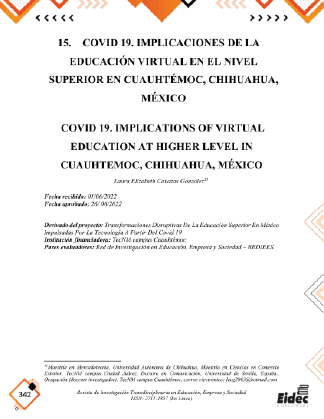XV. COVID 19. IMPLICATIONS OF VIRTUAL EDUCATION AT HIGHER LEVEL IN CUAUHTEMOC, CHIHUAHUA, MÉXICO
##plugins.themes.bootstrap3.article.main##
Abstract
JUSTIFICATION OF THE PROBLEM: The presence of the COVID-19
contingency, transmuted the teaching-learning styles, forcing the actors to venture without
prior training, into a disconcerting modality and solve problems on the fly, unquestionably
having repercussions on the educational standards. The how is the central theme of this
research. GENERAL OBJECTIVE: To infer the effects of virtual education in the teachinglearning process, in higher level students, in the region of Cuauhtémoc, Chihuahua.
METHODOLOGY/APPROACH: 428 surveys (designed for this research) were applied
online in various higher education institutions in the northwestern region of the state of
Chihuahua. The approach is mixed: qualitative and quantitative. RESULTS AND
CONCLUSIONS: The students qualify the virtual modality as regular, as they are prevented
from interacting with their classmates and when starting this process, 36% assumed it as a
challenge. 61% rate themselves with a "regular" two years away in school performance. 45%
accept that their learning styles have changed, managing self-learning. Connectivity issues
were rated on a regular basis. The most used platform was meet and zoom. The didactic and
evaluation strategies (mostly unintelligible exams) are considered "regular". The lack of
motivation and understanding of some teachers, connectivity problems and apathy were the
priority issues that they had to solve. The dropout rate increased.
Download Statistics
##plugins.themes.bootstrap3.article.details##
Disruption, Self-learning, Virtual Modality, Higher Education, Cuauhtémoc, Chihuahua
tiempos de pandemia, Estudios pedagógicos Valdivia, XLVI, No. 3: 213-223, Quito
Ecuador, DOI: https://doi.org/10.4067/S0718-0705202000030021,
https://bit.ly/3MpMlNR
Cavazos, L. (2014) Estrategias de comunicación para el desarrollo. Posibles aplicaciones en
el sector quesero menonita de Cd. Cuauhtémoc, Chihuahua. Tesis Universidad de
Sevilla, España, pags. 110-111 https://bit.ly/38Um9NF
CEPAL, (2020) Universalizing access to digital technologies to address the consequences of
COVID-19, Comisión Económica para América Latina y el Caribe Books and
Monographs, Institutional Documents and Books, https://bit.ly/39caI47
Enciclopedia de los Municipios (2020) Características de Cuauhtémoc, Chihuahua,
https://bit.ly/3zlIDBW
Grupo Banco Mundial (2020) Covid-19: Impacto en la educación y respuestas de política
pública, resumen ejecutivo, educación, página 6. https://bit.ly/3awXVtb
Llanos, B. (2021) Retos y desafíos de la educación en el confinamiento, ISBN Obra
Completa: 978-607-9064-23-5, Secretaría de Educación Pública, Michoacán,
México, págs. 11-15 https://bit.ly/3aqUmF3
Márquez, J. (2020) Educación a distancia ¿y la función de la socialización?
https://bit.ly/3tkrAMO
Remembranzas del Tecnológico (2020) Historia en video. https://bit.ly/3ar2HbP
Rochin, F. (2021) Deserción escolar en la educación superior en México: revisión de
literatura, Revista Iberoamericana para la Investigación y el Desarrollo Educativo,
versiñón on line ISSN 2007-7467 https://doi.org/10.23913/ride.v11i22.821,
https://bit.ly/3znfxT2
Zambrano, W., Meza, J (2022), Impacto de las tecnologías disruptivas en el proceso de
enseñanza – aprendizaje: Caso UTM online. Revista Científica UISRAE, versión online, ISSN 2631-2786, Quito Ecuador,
https://doi.org/10.35290/rcui.v9n1.2022.513 https://bit.ly/3xndOvm





